The ASUS ROG Delta II makes a strong first impression as a headset built for serious gaming sessions, blending premium audio quality with user-focused features. This latest model in the ROG Delta series brings several refinements, expanding on what previous versions offered with a fresh, streamlined approach. Now available in a clean white finish, it stands out not just in performance but also in style.
Designed to cater to both competitive gamers and those after immersive entertainment, the headset strikes a solid balance between flexibility and comfort. Whether you’re on PC, console, or mobile, it adapts easily across devices thanks to its multi-platform support. Despite its high-end focus, the Delta II remains easy to use, with thoughtful additions that enhance everyday use.
What sets this headset apart is its attention to detail, from the high-grade audio components to the simple convenience of fast wireless pairing. The addition of dual connectivity modes, a long-lasting battery, and swappable ear cushions make it a practical choice for gamers who spend hours in their setup. With its refreshed design and improved functionality, it’s made to handle whatever your gaming routine demands.
Design and Functionality
The ROG Delta II presents a sleek and modern look with its fresh white colourway, which brings a clean and minimalist aesthetic to a category often dominated by black or dark finishes. Its design retains the signature triangular earcups and lighting zones, offering subtle RGB accents that can be customised or turned off entirely.
Built for comfort over long sessions, the headset includes two types of ear cushions—PU leather and a hybrid fabric option—allowing users to choose based on preference or climate. Both styles are soft to the touch and provide ample padding, making it easy to wear the headset for extended periods without discomfort.
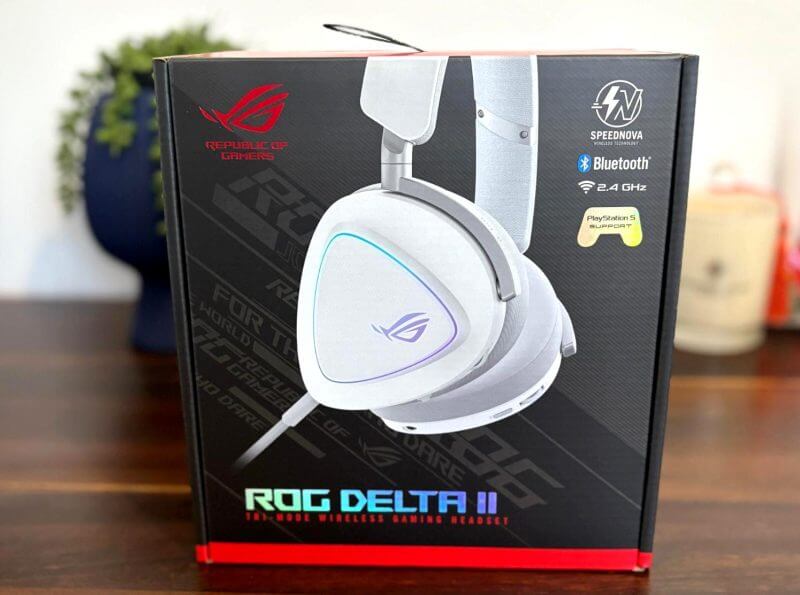

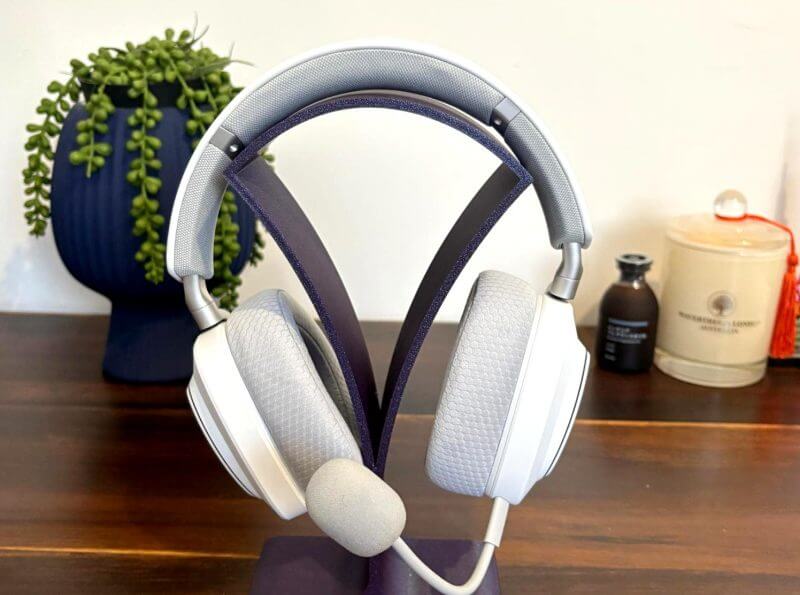
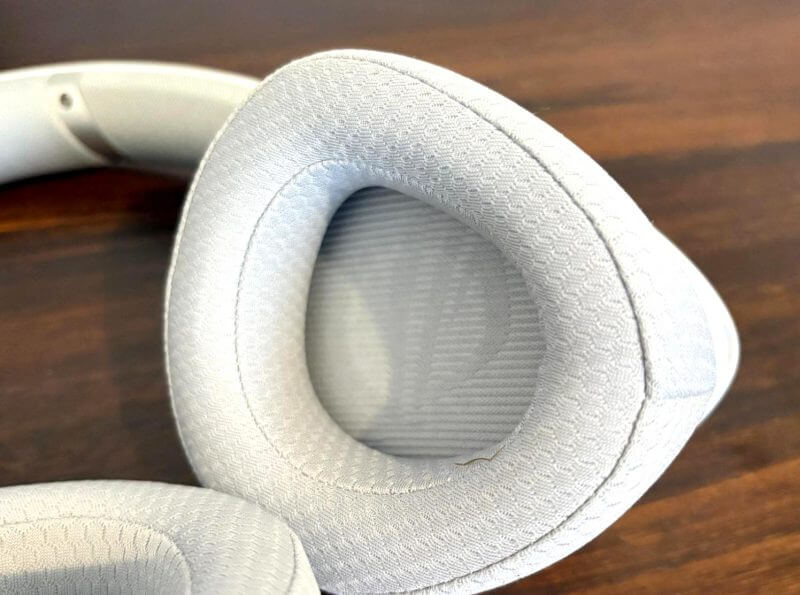
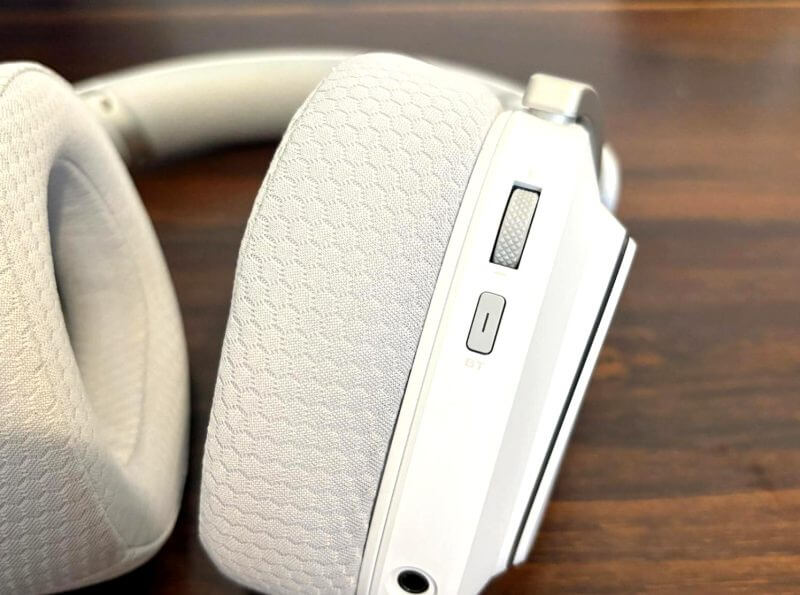
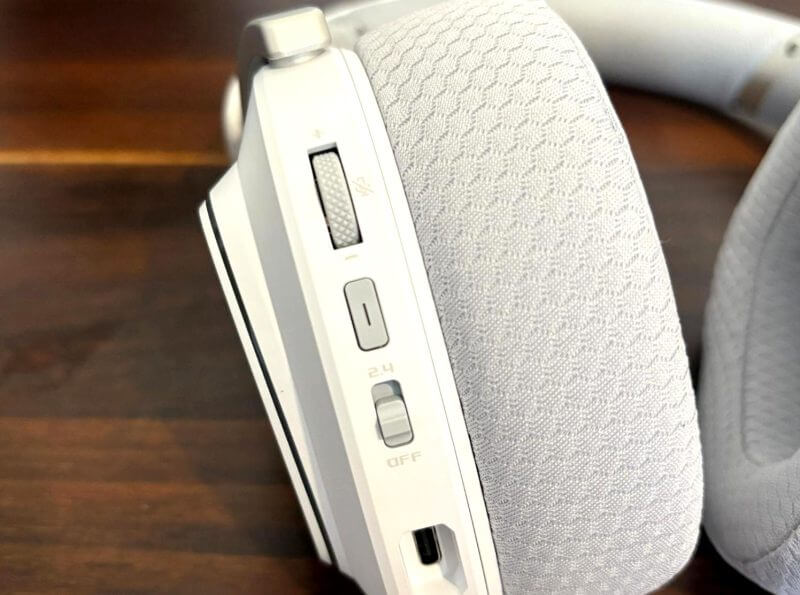
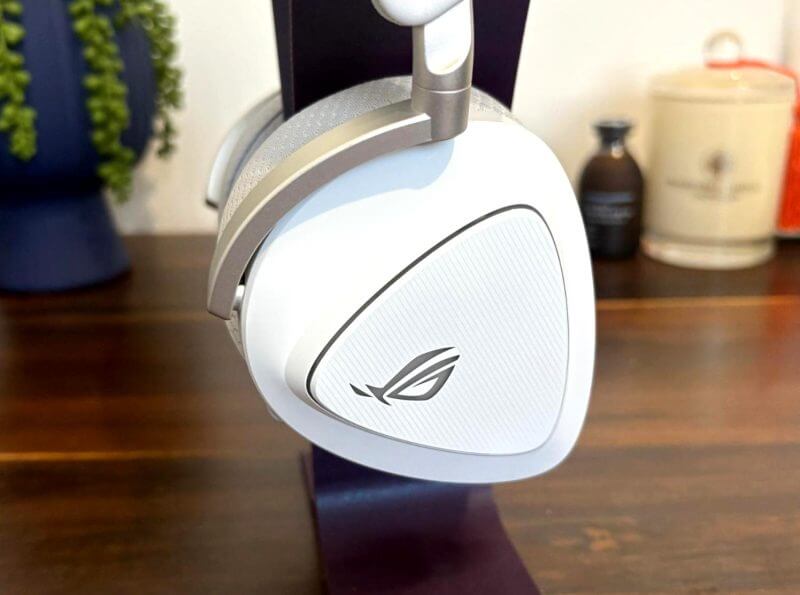
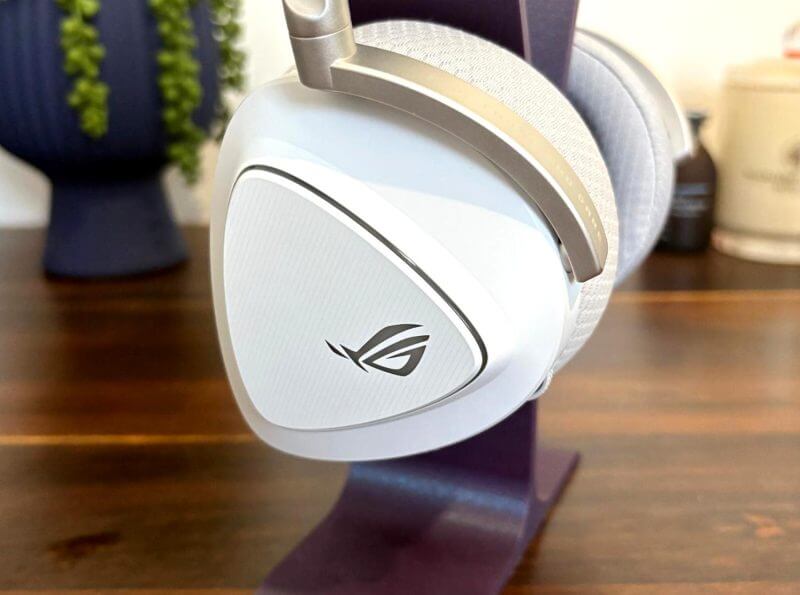
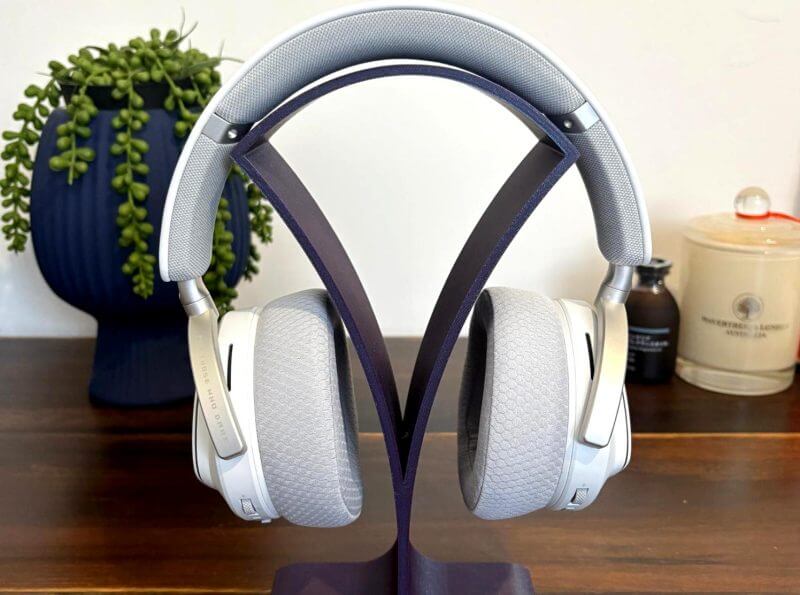
The triangular shape of the earcups isn’t just for style; it’s designed to match the contours of your ears, improving sound isolation and overall fit. Although the headset doesn’t fold, the earcups can swivel flat, allowing them to rest around your neck without feeling bulky or restrictive.
On the left earcup, users will find a cluster of controls designed for easy access mid-game. These include a multifunction dial for volume and microphone muting, a connection toggle for wireless mode, a USB-C charging port, and a dedicated slot for the detachable boom mic.
The right earcup houses the Bluetooth controls, which include its own volume wheel and a multifunction button for managing connections or switching between devices. A 3.5 mm input is also located here, giving players an alternative wired option if they prefer or need it.
Adjusting the fit is simple thanks to a sliding headband mechanism that locks into place with a soft but precise click at each level. This makes fine-tuning the size quick and intuitive, ensuring a snug fit without excessive pressure on the sides of your head.
The headset feels light in hand despite its solid construction, tipping the scales at just over 300 grams. This lighter weight, combined with the ergonomic D-shaped earcups, helps distribute pressure evenly across the head for better comfort during long gaming marathons.
Even the clamping force is well-balanced, firm enough to hold the headset securely in place without causing tension or fatigue. The breathable ear cushion material helps to keep things cool, which is especially noticeable in warmer environments or under intense gameplay.
Swapping between the included ear cushion types takes a bit of effort due to the clip-on system, rather than a magnetic attachment. However, once you decide on your preferred material, there’s little reason to make frequent changes, as both provide excellent passive isolation and comfort.
Key Features
One of the standout features of the ROG Delta II is its tri-mode connectivity, giving users the option to switch between low-latency 2.4GHz wireless, Bluetooth, or a traditional 3.5 mm wired connection. This level of flexibility makes it compatible with everything from PCs and consoles to tablets and smartphones.
ASUS includes its ROG SpeedNova wireless technology, which enhances the 2.4GHz mode by improving signal stability, reducing latency, and extending battery life. This feature is especially beneficial for competitive gamers where every millisecond counts during gameplay.
The headset also introduces DualFlow Audio, allowing it to receive audio from two different sources at the same time. This means you can be connected to a console via 2.4GHz and to a phone via Bluetooth simultaneously, making it easy to answer calls or listen to music between matches.
Powering the Delta II is an 1800 mAh internal battery that offers impressive longevity. When used in wireless mode with RGB lighting turned off, the headset can last up to 110 hours, while Bluetooth mode stretches that up to 140 hours under the same lighting conditions.
Charging is quick thanks to the fast-charge support, which provides around 11 hours of usage with just 15 minutes plugged in. This helps reduce downtime and ensures you’re ready to jump back into a game quickly after a short break.
The audio drivers used in the Delta II are titanium-plated and measure 50 mm, engineered to provide a rich, full sound across all frequencies. These drivers are tuned to deliver a balanced sound signature while offering clarity in everything from cinematic soundtracks to subtle in-game effects.
A detachable 10 mm boom microphone is included, offering wideband voice capture for better vocal clarity. While it doesn’t include active noise cancellation, its unidirectional pickup pattern focuses well on your voice, making it ideal for team chats and streaming.
Customisable RGB lighting rounds out the feature set, allowing users to sync lighting effects with other Aura Sync-enabled peripherals. It’s a visual bonus that adds flair without overwhelming the design, and it can be toggled off completely to conserve battery.
Experience Using the Product and Performance
Setting up the ROG Delta II is simple, with the headset automatically pairing to the 2.4GHz USB-C dongle the moment it’s switched on. The connection is both fast and reliable, with no noticeable delay even in high-paced gameplay.
Switching to Bluetooth is just as seamless, requiring only a few seconds of holding the designated button to reconnect to your last used device. It’s a great option for mobile gaming or media playback when you’re away from your main setup.
The inclusion of DualFlow Audio proved particularly useful during longer sessions, allowing music or notifications from a phone to play alongside game audio. This made multitasking easy without interrupting gameplay, especially when waiting in matchmaking queues.
Sound quality is a major highlight of the headset, with the 50 mm titanium-plated drivers producing clear, detailed audio across a wide range. Bass is controlled and punchy, mids are defined without being muddy, and treble remains crisp without sounding harsh.
The default ‘Flat’ EQ setting is ideal for a wide variety of content, providing balanced audio that suits both games and videos. However, switching to the ‘FPS’ preset sharpens directional audio cues, making it easier to pinpoint movements and spatial effects in competitive shooters.
Footsteps, reloads, and gunfire came through with precise positioning, particularly in titles like Apex Legends and PUBG. These details gave a noticeable edge when reacting to enemies approaching from behind or above.
The headset handles high-volume playback without distortion, even during chaotic in-game explosions or overlapping audio effects. Voices in dialogue-heavy games also came through with excellent clarity, maintaining immersion without needing frequent volume adjustments.
Wireless performance was stable across multiple environments, with no audio dropouts or interference in either 2.4GHz or Bluetooth mode. This consistency meant I could move freely around my workspace without worrying about cutting out mid-match.
The battery life exceeded expectations during daily use, easily lasting over a week on a single charge with lighting disabled. The fast-charging capability also came in handy, especially when I forgot to plug it in overnight and needed a quick top-up before a long gaming session.
The lightweight design worked well over extended periods, with no noticeable neck strain or head pressure even after hours of continuous use. The headband and ear cushions distributed weight evenly, making it easy to forget I was wearing a headset at all.
Microphone performance was solid, with team-mates commenting on the clear vocal pickup during multiplayer sessions. While not equipped with noise-cancelling tech, the boom mic still filtered out most ambient sounds effectively.
Swapping between devices was a smooth experience, as the headset remembered paired connections without needing to go through the setup process again. Whether I was using it on a console, PC, or tablet, the transition felt immediate and hassle-free.
Despite not folding for compact storage, the flat swivel design of the earcups made it convenient to carry the headset between rooms or pack into a bag. The absence of a carry case was a minor oversight, but the sturdy build held up well to daily movement.
Conclusion
The ASUS ROG Delta II successfully blends premium design with a versatile set of features that cater to gamers across multiple platforms. Its lightweight build and stylish white finish elevate the look without compromising on comfort or durability. Whether seated at a desk or playing on the go, it feels natural and effortless to wear.
With its tri-mode connectivity, the headset offers unmatched convenience for users who switch between devices. DualFlow Audio adds to this by allowing simultaneous playback from two sources, creating a more flexible and responsive experience. Fast charging and exceptional battery life further support long gaming sessions without interruption.
Sound quality stands as one of the headset’s strongest elements, with rich, balanced audio and well-tuned presets for different types of gameplay. The detachable mic performs reliably, ensuring clear communication without fuss. Every design choice appears made to enhance the user’s day-to-day experience without adding unnecessary complexity.
Altogether, the ROG Delta II proves to be more than just a good-looking headset—it’s a dependable piece of gaming gear built with serious players in mind. It feels like a long-term companion for anyone who values comfort, clarity, and cross-platform convenience. Let me know if you’d like this formatted for web, or need supporting assets like a meta description or social post.

